Insoles and orthotics for comfort and support in your walking shoes
Here’s the problem with typical insoles that come in most shoes:
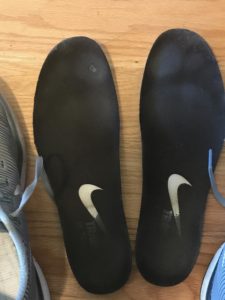
The insoles that come in most athletic shoes and hiking boots are woefully inadequate. Even when it’s an expensive, name-brand shoe, all you get is a cheap excuse for a footbed. In fact, the manufacturers don’t even call them footbeds… they’re “sock liners.”
As one veteran shoe salesman told me: “They’re useless.”
Stock sock liners provide almost no heel padding or arch support whatsoever.
Here’s an example from my personal collection of worn-out insoles and orthotics. These flimsy little things came in my Nike training shoes. They’re no more than two millimeters thick. You can see the wear… there’s actually a hole under the big toe after just three months of once-a-week wear. And the imprint of my foot is clear…
I wish I hadn’t waited so long to replace these with Superfeet. Walking, working out, or playing sports in shoes that have inadequate arch support and cushion, like those Nikes of mine, can actually cause foot problems. I can attest to that… for the first time in my life, I started getting heel pain.
Solution: Aftermarket insoles and orthotics
If you have plantar fasciitis or any minor foot pain, it’s a good idea to try a more substantial arch support in your walking shoes. Aftermarket insoles or custom orthotics can greatly enhance the comfort of most walking shoes and allow you more time on your feet. If you have flat feet or other foot issues, they’re an absolutely critical part of the equipment you need to continue walking.
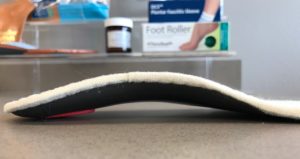
“Whenever someone buys a new pair of walking or running shoes, we always recommend an aftermarket insole.” – Nordstrom shoe salesman.
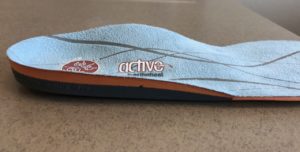
Enhanced comfort
A good insole is anatomically engineered to help minimize shock on the feet and improve the performance of any walking shoe. The best insoles are molded to cup the heel, support the arch, and hold the forefoot in place.
People with high arches definitely need these aftermarket insoles. (You can determine your arch type simply by stepping onto a piece of paper with wet feet.

Make sure your insoles match the profile of your arch.
I’ve made this mistake, and it hurt like hell! I bought aftermarket insoles that had too much arch support for my feet. My foot profile was somewhere between “normal” and “high” but the insoles were more suited for “very high” arches. It’s the first time in my life that I’ve experienced severe heel pain.
Insoles and Custom Orthotics are like prescription eyeglasses for the feet.
They’re made to correct the specific biomechanics of the way you walk.
They are preventative protection against common foot problems like pronation, plantar fasciitis or fallen arches.
Insoles and orthotics are not only preventive solutions. They are also used in the treatment of a wide range of foot conditions including plantar faciitis, toe pain, knee pain, corns, metatarsalgia, Achilles tendon pain, heel pain, bunions, and other conditions.
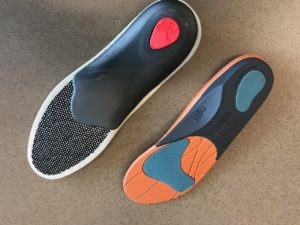
If you have serious foot pain, please be sure to consult a physician. No footbed is the replacement for a knowledgable podiatrist.
NOTE: Even the best insoles wear out. Podiatrists and sports foot specialists recommend that you replace your insoles at least once a year if you’re using them regularly. The marketing hype from the insole manufacturers says they last 6 to 9 months.
Here’s our partial list of the best insoles and orthotics for walking shoes:
Superfeet Blue Premium Insoles
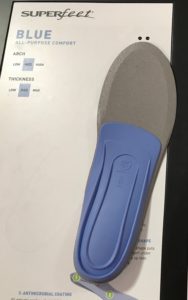
I started using Superfeet insoles in my ski boots 20 years ago, and now they’re standard equipment in all my shoes.
Long-lasting support packed into a thinner, high-performance insole, Superfeet BLUE were designed to improve the overall fit and performance of a wide range of footwear. The biomechanical shape and design have made the BLUE one of Superfeet’s most popular insoles year after year.
I have somewhat high arches, so Superfeet Blue is the right insoles for me. (I tried Superfeet Green and they really hurt!) These are medium-profile insoles with the shape that can fit into most footwear most types of footwear, even some with non-removable factory insoles.
1. Stabilizer Cap: The rails reinforce the narrow cap to provide structure and support.
2. Heel Cup: Helps position the heel to naturally absorb impact.
3. Bio-Mechanical Shape: The medium-profile shape puts biomechanical support under your foot, but takes up less space in the shoe.
4. High-Density Foam Layer: Closed-cell foam supports and cushions the foot for long-lasting comfort.
5. Organic, Odor-Control Coating: All natural coating that eliminates odor-causing bacteria.

